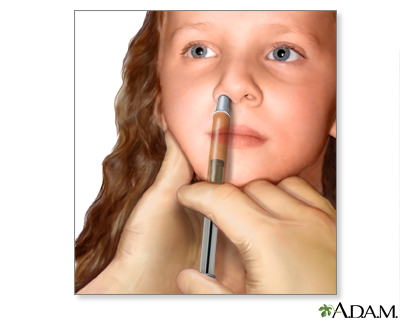|
Return to Biology 1114 Index Page |
||||||||||||||||
|
Use a #2 pencil to fill in the information on your NCS answer sheet. Put your O-Key Account Username in the boxes indicated for LAST NAME and darken the appropriate circles. Write your Name (Last, First) and “Star” in the space above the boxes containing your O-Key Account Username. Darken the (S) in the last column of the name circles. Enter the number 933 and darken the corresponding circles in the first 3 columns of the “Student ID.” Failure to perform this correctly will incur a -10pt handling fee. Read all questions and answers carefully before choosing the single BEST response for each question. Feel free to ask the instructor for clarification. | ||||||||||||||||
|
| ||||||||||||||||
|
Johnny’s parents incorrectly decide that he is not sick and infectious (even though he has a 101° F fever) and send him off to school.
Suzy is given an annual influenza vaccine.  Source | ||||||||||||||||
|
Dr. Tom Schoener is interested in the ecology of web spiders. He goes to a small island in the Caribbean and counts 70 web spiders on the 40m2 island. The birth rate of the web spiders is 4.4 spiders per year per spider and the death rate is 0.6 spiders per year per spider.
 Source | ||||||||||||||||
|
Park rangers also monitored the park’s elk population, a favored prey of the wolves. | ||||||||||||||||
 Source Last year, the Center for Disease Control (CDC) advocated use of an influenza vaccine against the H3N2 strain of flu. The H and N (i.e., hemagglutinin and neuraminidase) antigens are proteins that are inserted into this virus’ lipid envelope and resemble railroad spikes. 16 subtypes of H and 9 subtypes of N are currently known to occur in viruses that infect humans and animals. The numbers after H and N represent the viral subtypes, or variations in the amino acids sequences of H and N that may occur. In April of 2009, the infamous H1N1 flu strain (i.e.,swine flu) reappeared in several outbreaks in the U.S. This flu strain killed at least 50 million people worldwide in 1918-1919! In the U.S., influenza annually kills about 36,000 people, most of whom were older than 65. New medications like Tamiflu reduce flu symptoms and may limit spread of the virus within the body.
The adventurous field mice that have been invading the college campus are white-footed mice (Peromyscus leucopus). Although nearly all white footed mice have a brown coat, a few are golden tan, a trait that is referred to as Golden Nugget and is X-linked recessive. 
Source Peanuts are packed with protein and fats that are carbon based materials. Three linked amino acids in a peanut protein are glutamine-tyrosine-cysteine.
Dog breeds represent a wide range of phenotypes. Many dogs are classified by their facial features. Short-nosed dogs have an upper jaw that is shorter than the lower jaw. Many short-nosed dogs were bred for fighting and commonly have breathing problems associated with narrow passageways. Long-nosed dogs have an upper jaw that is longer than the lower jaw. These long-nosed dogs were bred for chasing prey at high speeds. Medium-nosed dogs have an upper and lower jaw of equal length and represent dogs with versatile purposes. One gene is responsible for the inheritance of jaw length. A breeder would like to design a new variety of dog called the Bullzoi, the result of a cross between an English Bulldog (dd) and a Borzoi (DD). The breeder decides to mate two dogs and the resulting offspring contains 2 long-jawed dogs, 4 medium-jawed dogs, and 2 short-jawed dogs. Borzoi’s, long-jawed dogs, were bred to chase fast prey. They have long slender bodies to increase speed and have a very keen sense of sight. The breeder has noticed that many of her previous Borzoi’s have developed skin cancer. She also notices that many of her Borzois like to spend a lot of time in the sun. She hypothesizes that her Borzoi’s develop skin cancer because they spend a lot of time in the sun and the UV light damages the DNA of skin cells. One of the breeder’s long-jawed Borzoi develops a skin growth. The veterinarian has diagnosed the dog with skin cancer caused by UV exposure. The breeder’s attempt to breed a Borzoi unfortunately has also selected for more aggressive dogs. One Borzoi attacks her and she has to go to the hospital to replace her lost blood. A blood test shows that her blood type is B. Further analysis of the dog’s skin cancer reveals that part of the DNA sequence changed from CATGCTTCCCGT to CATGGCTTCCCGT. |



